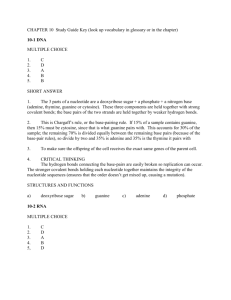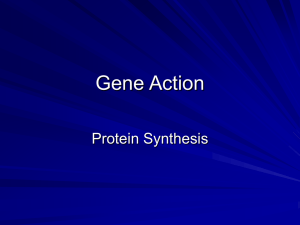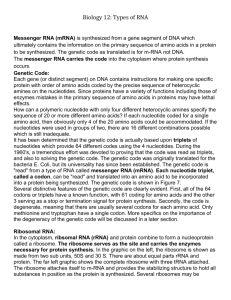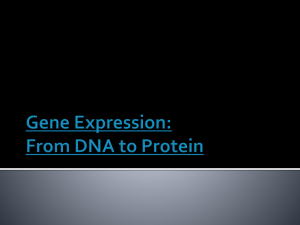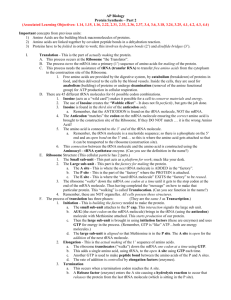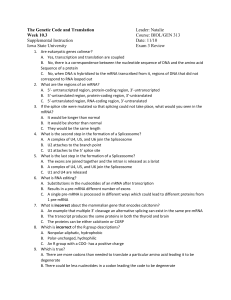Chapter 13 —Test A Multiple Choice 1. c 2. a 3. a 4. d 5. a 6. b 7. d 8
advertisement
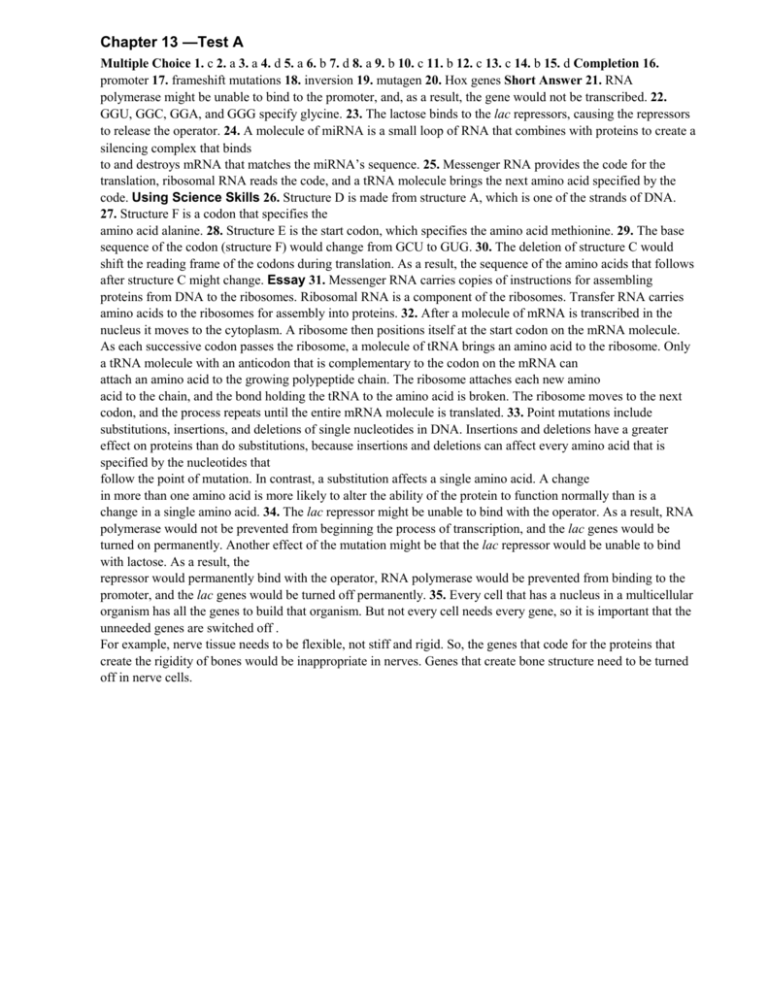
Chapter 13 —Test A Multiple Choice 1. c 2. a 3. a 4. d 5. a 6. b 7. d 8. a 9. b 10. c 11. b 12. c 13. c 14. b 15. d Completion 16. promoter 17. frameshift mutations 18. inversion 19. mutagen 20. Hox genes Short Answer 21. RNA polymerase might be unable to bind to the promoter, and, as a result, the gene would not be transcribed. 22. GGU, GGC, GGA, and GGG specify glycine. 23. The lactose binds to the lac repressors, causing the repressors to release the operator. 24. A molecule of miRNA is a small loop of RNA that combines with proteins to create a silencing complex that binds to and destroys mRNA that matches the miRNA’s sequence. 25. Messenger RNA provides the code for the translation, ribosomal RNA reads the code, and a tRNA molecule brings the next amino acid specified by the code. Using Science Skills 26. Structure D is made from structure A, which is one of the strands of DNA. 27. Structure F is a codon that specifies the amino acid alanine. 28. Structure E is the start codon, which specifies the amino acid methionine. 29. The base sequence of the codon (structure F) would change from GCU to GUG. 30. The deletion of structure C would shift the reading frame of the codons during translation. As a result, the sequence of the amino acids that follows after structure C might change. Essay 31. Messenger RNA carries copies of instructions for assembling proteins from DNA to the ribosomes. Ribosomal RNA is a component of the ribosomes. Transfer RNA carries amino acids to the ribosomes for assembly into proteins. 32. After a molecule of mRNA is transcribed in the nucleus it moves to the cytoplasm. A ribosome then positions itself at the start codon on the mRNA molecule. As each successive codon passes the ribosome, a molecule of tRNA brings an amino acid to the ribosome. Only a tRNA molecule with an anticodon that is complementary to the codon on the mRNA can attach an amino acid to the growing polypeptide chain. The ribosome attaches each new amino acid to the chain, and the bond holding the tRNA to the amino acid is broken. The ribosome moves to the next codon, and the process repeats until the entire mRNA molecule is translated. 33. Point mutations include substitutions, insertions, and deletions of single nucleotides in DNA. Insertions and deletions have a greater effect on proteins than do substitutions, because insertions and deletions can affect every amino acid that is specified by the nucleotides that follow the point of mutation. In contrast, a substitution affects a single amino acid. A change in more than one amino acid is more likely to alter the ability of the protein to function normally than is a change in a single amino acid. 34. The lac repressor might be unable to bind with the operator. As a result, RNA polymerase would not be prevented from beginning the process of transcription, and the lac genes would be turned on permanently. Another effect of the mutation might be that the lac repressor would be unable to bind with lactose. As a result, the repressor would permanently bind with the operator, RNA polymerase would be prevented from binding to the promoter, and the lac genes would be turned off permanently. 35. Every cell that has a nucleus in a multicellular organism has all the genes to build that organism. But not every cell needs every gene, so it is important that the unneeded genes are switched off . For example, nerve tissue needs to be flexible, not stiff and rigid. So, the genes that code for the proteins that create the rigidity of bones would be inappropriate in nerves. Genes that create bone structure need to be turned off in nerve cells.

